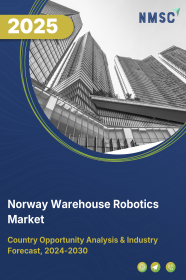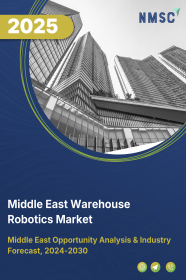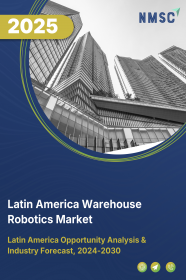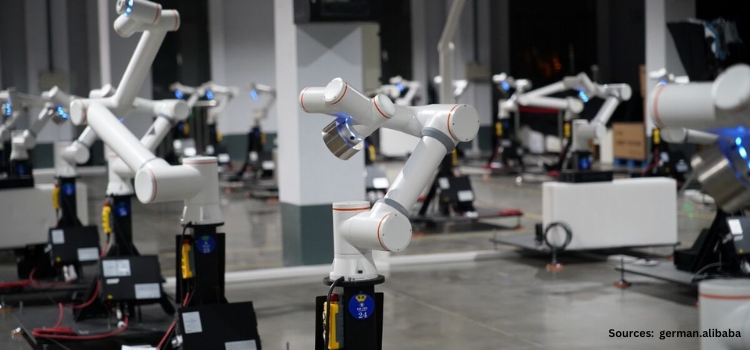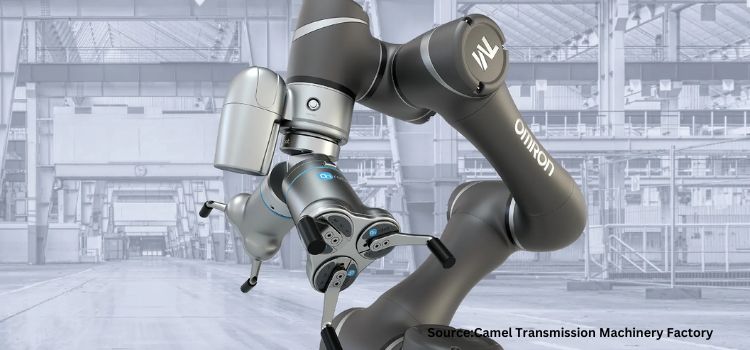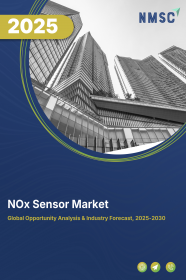
NOx Sensor Market by Type (Nitric Oxide (NO), Nitrogen Dioxide (NO2), and Nitrous Oxide (N2O)), by Technology (Electrochemical Sensor, Chemiresistor Sensor, and Solid-State Sensor), by Application (Powertrain, Body Electronics, Vehicle Security Systems, Safety & Controls, Telematics, and Others), and by End-User (Automotive, Industrial, Transportation, and Logistics)– Global Opportunity Analysis and Industry Forecast 2025-2030
NOx Sensor Market Overview
The global NOx Sensor Market size was valued at USD 2.42 billion in 2024 and is predicted to reach USD 5.50 billion by 2030 with a CAGR of 14.7% from 2025-2030.
The NOx sensor market refers to the global industry that focusses on the production, distribution, and utilization of nitrogen oxide sensor. These sensors are essential devices used across various sectors to monitor and manage the presence of nitrogen oxides in emissions. These sensors employ technologies such as electrochemical and optical sensing to detect and measure NOx levels accurately.
They play a critical role in emissions control systems, ensuring compliance with strict environmental standards while optimizing combustion processes. By providing precise data on NOx emissions, these sensors contribute significantly to mitigate air pollution and advance environmental sustainability.
Market Dynamics and Trends
The global rise in the adoption of clean energy is driving the NOx sensor market growth, as industries and power generation facilities use cleaner fuels to meet emission regulations, increasing the demand for nitrogen oxide sensors to monitor and control nitrogen oxide emissions effectively.
A report from Gas Exporting Countries Forum states that the expansion of natural gas demand is primarily driven by power generation sector with demand growing to 500 billion cubic meters, accounting for 37% of total growth in natural gas demand by 2050. Such high adoption rate of cleaner fuels accelerates the demand for advanced sensor to check the emissions level efficiently.
Moreover, expansion of industrialization worldwide is significantly driving the demand for NOx sensors, as industries require these sensors to monitor emissions in real-time, ensuring compliance and providing data to optimize combustion processes and enhance efficiency.
United Nations Industrial Development Organisation states that, there was a 2.3% growth in global industrial sectors in 2023. Additionally, the demand for natural gas from industrial sector is expected to reach 275 billion cubic meters, an increase of 20% from 2022 to 2050. Such growth in industries demands advanced emission detectors to enhance efficiency and minimize environmental impact.
Furthermore, the surge in automotive industry worldwide is significantly driving the nitrogen oxide sensor market, as these sensors monitor and regulate nitrogen oxide emissions from vehicle exhausts, providing real-time feedback to the engine control unit for precise adjustments and efficient combustion.
According to recent report published by European Automobile Manufacturers’ Association, in 2022, 85.4 million motor vehicles were produced around the world, showing an increase of 5.7% compared to 2021. Such high vehicle production increases the demand for nitrogen oxide sensor to ensures compliance with regulations and enhance air quality and sustainability efforts.
However, the substantial upfront expenses associated with NOx sensor installation and high maintenance costs of the devices is restraining the growth of the NOx sensor market expansion.
On the contrary, the integration of NOx sensor with technologies such as MEMS (Microelectromechanical Systems) sensor and optical-based NOx sensing is anticipated to create ample growth opportunity in the forthcoming years. These technologies enable miniaturization and light-based detection methods such as absorption spectroscopy, ensuring rapid response times and exceptional accuracy.
Market Segmentations and Scope of the Study
The NOx sensor market report is segmented on the basis of type, technology, application, end-user, and region. Based on type, the market is divided into nitric oxide (NO), nitrogen dioxide (NO2), and nitrous oxide(N2O). Based on technology the market is segmented into electrochemical sensor, chemiresistor sensor, and solid-state sensor. Based on application, the market is categorised into powertrain, body electronics, vehicle security systems, safety & controls, telematics, and others. On the basis of end-user, the market is divided into automotive, industrial, and transportation & logistics. Regional breakdown and analysis of each of the aforesaid segments includes regions comprising of North America, Europe, Asia-Pacific, and Rest of The World (Row).
Geographical Analysis
North America dominates the NOx sensor market share during the forecast period. The expansion of transportation sector in the region including fleet operators, logistics firms, and public transit agencies accelerates the demand for nitrogen oxide sensor to look into the emission rate of the vehicles operating within them. As per Bureau of Transportation Statistics, transportation services contributed 6.7% to U.S. GDP in 2022. Such growth in the sector demands emission detecting sensor to reduce the environmental impact of transportation activities.
Moreover, the rising adoption of natural gas across various sectors in the region is driving the demand for NOx sensor to detect emissions and meet stringent emissions regulations. U.S Energy Information Administration states that, in 2022, U.S. consumed about 32.31 trillion cubic feet of natural gas. Such high consumption rate increases the demand for nitrogen oxide sensor to efficiently monitor emissions and comply with regulations.
On the other hand, Asia-Pacific is expected to witness a steady rise in the NOx sensor market demand, due to the expansion of automotive industry especially in countries such as Japan, China and South Korea.
International Trade Administration states that, Japan's automotive sector accounted for 2.9% of the nation's GDP and 13.9% of the manufacturing GDP in 2022. As the automotive sector is showing such significant growth, the demand for nitrogen oxide sensor as an essential technology for ensuring compliance with stringent emissions regulations and enhancing environmental sustainability is increasing.
Moreover, the expansion of the manufacturing sector in this region is significantly driving the demand for NOx sensors, as increased manufacturing activity results in higher nitrogen oxide emissions, necessitating regular monitoring to ensure emission rates comply with regulatory standards.
According to recent report published by China’s State Council Information, China's manufacturing industry, constituted 27.7% of its GDP in 2022, and has maintained its global lead for 13 consecutive years. With such surge in manufacturing activity there is growing focus on environmental sustainability and adherence to strict emissions regulations, thereby driving the growth of the market.
Competitive Landscape
Various key players operating in the NOx sensor industry includes Ford Motor Company, Robert Bosch LLC, Continental Automotive Technologies GmbH, Vitesco Technologies, Inc., Delphi Technologies PLC, Niterra Co., Ltd., Dinex A/S, NGK INSULATORS, LTD., Sensirion AG, STMicroelectronics, Standard Motor Products, Inc., HELLA GmbH & Co. KGaA, Walker Products, Cummins Inc, Skyline Emissions, Inc., and others. These market players are adopting various strategies such as product launches to remain dominant in the market.
For instance, in December 2023 Delphi Technologies Plc launched 36 new nitrogen oxide sensors for monitoring pollution levels and ensuring compliance with emission regulations. The sensor is crafted for a wide range of passenger car and commercial vehicle brands across Europe, the Middle East, and Africa, and designed to fit over 70 million vehicles.
Moreover, in July 2023, Viteso Tech launched direct sales of OE-manufactured spare parts in the Independent Aftermarket (IAM). It aims to provide a full range of spare parts and services for electric vehicles, including passenger cars and commercial vehicles. They aimed to offer premium OE-quality NOx sensor for about 300 vehicle models, essential for meeting emission regulations.
Key Benefits
-
The report provides quantitative analysis and estimations of the NOx sensor industry from 2025 to 2030, which assists in identifying the prevailing market opportunities.
-
The study comprises a deep-dive analysis of the current and future NOx sensor market trends to depict prevalent investment pockets in the market.
-
Information related to key drivers, restraints, and opportunities and their impact on the market is provided in the report.
-
Competitive analysis of the players, along with their market share is provided in the report.
-
SWOT analysis and Porters Five Forces model is elaborated in the study.
-
Value chain analysis in the market study provides a clear picture of roles of stakeholders.
NOx Sensor Market Key Segments
By Type
-
Nitric Oxide (NO)
-
Nitrogen Dioxide (NO2)
-
Nitrous Oxide and (N2O)
By Technology
-
Electrochemical Sensor
-
Chemiresistor Sensor
-
Solid-State Sensor
By Application
-
Powertrain
-
Body Electronics
-
Vehicle Security Systems
-
Safety & Controls
-
Telematics
-
Others
By End User
-
Automotive
-
Industrial
-
Transportation & Logistics
By Region
-
North America
-
The U.S.
-
Canada
-
Mexico
-
-
Europe
-
The U.K.
-
Germany
-
France
-
Italy
-
Spain
-
Denmark
-
Netherlands
-
Finland
-
Sweden
-
Norway
-
Russia
-
Rest of Europe
-
-
Asia-Pacific
-
China
-
Japan
-
India
-
South Korea
-
Australia
-
Indonesia
-
Singapore
-
Taiwan
-
Thailand
-
Rest of Asia-Pacific
-
-
Rest of the World (RoW)
-
Latin America
-
Middle East
-
Africa
-
Key Players
-
Ford Motor Company
-
Robert Bosch LLC
-
Continental Automotive Technologies GmbH
-
Vitesco Technologies, Inc.
-
Delphi Technologies PLC
-
Niterra Co., Ltd.
-
Dinex A/S
-
NGK INSULATORS, LTD.
-
Sensirion AG
-
STMicroelectronics
-
Standard Motor Products, Inc.
-
HELLA GmbH & Co. KGaA
-
Walker Products
-
Cummins Inc
-
Skyline Emissions, Inc.
REPORT SCOPE AND SEGMENTATION:
|
Parameters |
Details |
|
Market Size in 2024 |
USD 2.42 billion |
|
Revenue Forecast in 2030 |
USD 5.50 billion |
|
Growth Rate |
CAGR of 14.7% 2025 to 2030 |
|
Analysis Period |
2024–2030 |
|
Base Year Considered |
2024 |
|
Forecast Period |
2025–2030 |
|
Market Size Estimation |
Billion (USD) |
|
Growth Factors |
|
|
Countries Covered |
28 |
|
Companies Profiled |
15 |
|
Market Share |
Available for 15 companies |
|
Customization Scope |
Free customization (equivalent to up to 80 working hours of analysts) after purchase. Addition or alteration to country, regional, and segment scope. |
|
Pricing and Purchase Options |
Avail customized purchase options to meet your exact research needs. |

















 Speak to Our Analyst
Speak to Our Analyst



